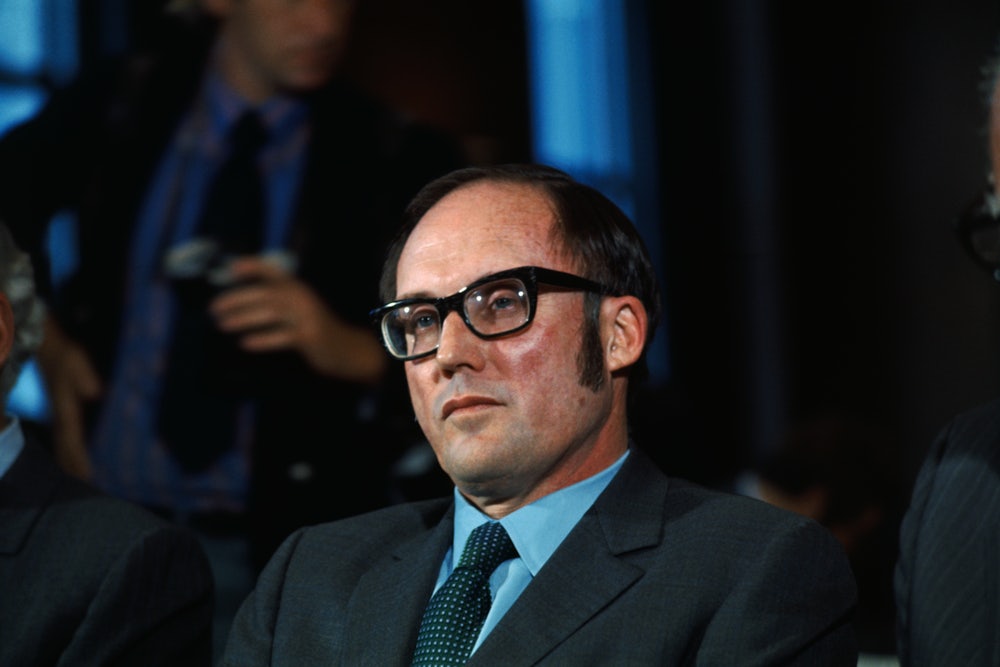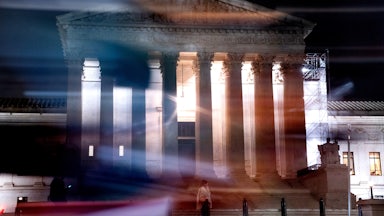On a balmy day in
November 1962, a Republican activist set up shop in a poor precinct in South
Phoenix. He wasn’t there to vote or volunteer with the nonpartisan poll
workers. He came to harass Black voters. The man—who was white and tall—quizzed
would-be voters about their backgrounds and demanded they recite the
Constitution to him. “You are not able to read, are you?” he reportedly asked
Black people as they queued up to vote outside an elementary school. “You have
no business being in this line trying to vote. I would ask you to leave.”
Multiple witnesses identified
the rangy man as William Rehnquist. In 1962, that name didn’t carry much weight
beyond the arid desert town yet to boom from an influx of industry and
affordable air conditioning. Phoenix politicos saw him as a partisan gadfly,
not a power broker. Local civil rights activists had long complained about his
obnoxious buzzing, which came in his Election Day visits to minority
neighborhoods and his obstreperous opposition to desegregation laws. (Rehnquist
once ranted
that a modest local proposal to ban racial discrimination by public-facing businesses
was a “drastic” “assault” on “a man’s private property” and “the historic right
of the owner of a drug store, lunch counter or theater to choose his own
customers.”) He was, a leader in the Arizona NAACP noted,
“the only major person of stature in the state who opposed the Arizona civil
rights bill,” his legal pedigree and polish standing out in the morass of
cranks, Birchers, and avowed racists who advocated for keeping segregation
legal.
In less than a decade,
Rehnquist would go from a local antagonist to a conservative avatar on the
Supreme Court. From his lofty perch as a justice (and later, chief justice), he
led a swashbuckling counterrevolution against the equality vision of the liberal
Warren court. He would reshape the Constitution that he once wielded as a
weapon of voter suppression, bolstering states’ rights at the expense of
individual liberties.
With the Supreme Court back
in session, Rehnquist’s legacy looms over the conservative majority. Perhaps
more than any other figure, he embodies the fervor and tensions of the Roberts court. Today’s Republican-appointed justices share similar allegiances: to a lost
Constitution, unmarred by the reforms of Reconstruction, the New Deal, and the
Warren court; to the Republican Party and its situational needs; to a muscular
and unapologetic judiciary that imposes conservative change on the country.
They also grapple with
the same challenge that haunted Rehnquist: how to impose that change in a form
and language the country can tolerate. On the bench, Rehnquist could be a hard-charging
ideologue, the vote-suppressing Republican operative never far from the surface.
Yet he was also a tactician who could temper his zeal to lurch law right
because of the larger cultural, political, and social web surrounding the court. His jurisprudence, considered in its totality, was riddled with
conflict, caught between advancing an ultraconservative agenda and recognizing that
his agenda sometimes had to give way to the public’s values, America’s
constitutional tradition, and the legal profession’s conventions.
The modern Republican appointees inherit Rehnquist’s doctrine and dissonance. In many cases, they are indifferent to the dynamic between the court and the broader constitutional culture, steamrolling through precedents and norms to reach desired outcomes. In others, they pull back, battling among themselves about how big and fast their moves should be. Some of the conservatives recognize the precariousness of the court’s position in the broader political landscape and the importance of attending to this dynamic, or at least the public perception of doing so. Some lack this sensitivity, and others still shift between these camps on a case-by-case basis. The internal conflicts and contradictions of an individual are now those of an institution.
It is no wonder, then, that the court’s six conservatives are practically in competition over how many times they can cite Rehnquist in their opinions—including some of the most consequential ones, such as the Dobbs decision overturning Roe v. Wade. In that sense, Rehnquist’s shadow doesn’t just loom over the justices; it looms over all of us. And revisiting his legacy in the context of today’s right-wing court could provide clues about where our country is headed.
Rehnquist’s judicial
philosophy was eloquently summarized in a 1982
essay in The New Republic by
Yale Law professor Owen Fiss and political columnist Charles Krauthammer. They argued
Rehnquist—now a decade on the court, though still four years away from becoming
chief justice—had a “constitutional program” aimed at “free[ing] the states
from the restrictions of the national Constitution, particularly those
emanating from the Civil War Amendments and the Bill of Rights.” This program
had a clear political valence. By transferring power to the states, diminishing
Congress’s authority, and curtailing the rights of racial minorities, the poor,
and prisoners, it closely mirrored President Ronald Reagan’s “new federalism.” These
ideas—and Rehnquist’s willingness to express them through lonely dissents—made
him a “hero to conservatives.” But Fiss and Krauthammer argued his program was
more subversive than conservative; that he was “a revisionist of a particular ideological
bent.”
A generation of
conservatives soon embraced this ideological bent. Rehnquist hired future
luminaries like Senator Ted Cruz and Chief Justice John Roberts to be his law
clerks, helping to shape their views and vault them into the stratosphere of
law and politics. “Rehnquist reinforced John’s preexisting philosophies,” recalled
Paul Smith, a lawyer who clerked for Justice Lewis Powell the same term as
Roberts clerked for Rehnquist. “John was not a believer in the courts giving
rights to minorities and the downtrodden. That was the basic Rehnquist
philosophy.” Rehnquist inspired others from afar. Justice Brett Kavanaugh has called
Rehnquist his “first judicial hero,” while Justice Samuel Alito has cited him
as one of his favorite justices.
Rehnquist made much of
his constitutional program into national precedent. He led the court in curbing
the habeas rights of prisoners and expanding police powers, allowing officers
greater leeway in searches and limiting ways to hold them accountable for violating
constitutional rights. His relentless push for state sovereignty structurally
changed the relationship between the states and the federal government—a
constitutional revolution his epigones would build on. (Roberts would
consciously draw on Rehnquist’s federalism ideas in his opinions gutting the
Affordable Care Act’s Medicaid expansion and the heart of the Voting Rights Act.)
Yet some goals remained elusive, often thwarted by Justice Anthony Kennedy’s old-school
Republican stance on social issues like abortion and affirmative action.
The late 1980s and 1990s
revealed an unexpected evolution. Upon becoming chief justice in 1986,
Rehnquist seemed to absorb the role’s institutional weight. His approach grew
more nuanced and pragmatic, though his core beliefs remained intact. The court’s
onetime conservative edge found himself outflanked by Justices Antonin Scalia and Clarence Thomas.
Consider the 1996 case of
United States v. Virginia. Justice Ruth Bader Ginsburg, writing for the
majority of the court, mandated women’s admission to Virginia’s military
academy; Scalia, dissenting for himself, wrote an elegy for patriarchy,
lamenting the death of “manly honor.” Rehnquist chose a middle path. By
concurring in the result, but not reasoning, of Ginsburg’s majority opinion, he
preserved existing precedents on women’s equality that had strong public
support while resisting their expansion—a characteristic late-career balance
between principle and pragmatism.
This institutional awareness could yield surprising outcomes. Despite years of limiting protections for criminal suspects, Rehnquist declined to overturn Miranda v. Arizona in 2000’s Dickerson v. United States. Writing for all but Scalia and Thomas, he acknowledged Miranda’s flaws but deemed the precedent, which created a constitutional requirement that law enforcement inform suspects of their rights to remain silent and to have an attorney during interrogations, to be “part of our national culture.” The opinion reflected less an embrace of Miranda than a pragmatic defense of court authority—marking how far the onetime Phoenix poll watcher had come.
When Rehnquist died in
2005, his former clerk, John Roberts, replaced him as chief justice. This falls
marks Roberts’s twentieth term atop the court, which has become a profoundly different
institution under his leadership. Since Rehnquist often lacked a court majority
backing his most radical views, his solo opinions could be intellectually
daring. Today, the court’s conservatives command such a majority but lack his
intellectual imagination and vigor. They struggle particularly with what Fiss
and Krauthammer identified as originalism’s core challenge: the “epistemological
and evidentiary problems” of using 1787 as an interpretive guide for modern
questions.
The legal right’s
triumphs have also opened the door for new causes to animate conservatism. Rehnquist’s
vaunted federalism revolution had already remade American government by the
time Roberts took over; two decades later, Roe, affirmative action, and
the Voting Rights Act lie in ruins. With the proverbial dog having caught the
constitutional car, Rehnquist’s federalism revolution has given way to an
entirely different campaign. His “radical view of state autonomy” sought to “impos[e]
strict limits on the powers of the federal courts and Congress,” to quote Fiss
and Krauthammer, originating in backlash to the desegregation struggles and egalitarianism
of the Warren court and Congress in the civil rights era. The new conservatives
came of legal age when courts were already retreating from that vision. Rather
than impose strict limits on the judiciary, the modern conservatives tear them down,
knowing federal courts have become bastions of conservative power. The most
striking example of these judicial power grabs came in June in Loper Bright
Enterprises v. Raimondo, when the court’s conservatives overturned Chevron
v. NRDC, a unanimous decision from Rehnquist’s tenure that checked
federal courts’ powers to supplant federal agencies’ reasonable interpretations
of ambiguous statutes with their own.
The titanic clashes
between the court’s conservative wing and Congress that characterized the
Rehnquist era have receded from the docket. While the conservative majority
still curtails congressional power, the governmental branch it primarily
fights with is the executive, particularly Democratic administrations operating
through federal agencies. Congress, once a formidable opponent, has been
hobbled by polarization, byzantine procedural rules, calcified institutional
design, and the obstructionist playbook of the post-Gingrich GOP. At the same
time, the conservative banner of states’ rights has lost some of its luster.
The court’s right-leaning justices regularly undercut the autonomy of
progressive states like California, invalidating its attempts to enact laws
addressing pollution, discrimination, gun violence, forced arbitration, and
labor conditions.
The cultural conversation around the Supreme Court has also shifted. Many liberals—sometimes deliberately but often unthinkingly—have responded to the court’s sharp rightward turn by echoing the right’s past critiques of the court, denouncing “judicial activism” and overreach. Simultaneously, many conservatives embrace a dated liberal vocabulary that portrays courts as noble defenders of rights. This role reversal appears in the justices’ own rhetoric: Justice Elena Kagan’s dissents channel Scalia’s style in warning against “black-robed rulers,” while Kavanaugh invokes the Warren court and Brown v. Board of Education to defend decisions that actually erode their legacy.
Even as the court’s conservatives
navigate a world unlike Rehnquist’s, his influence is everywhere. Take the
craft of Supreme Court opinions. He viewed opinions not as isolated case
resolutions but as moves in a longer constitutional chess game. As Fiss and
Krauthammer observed, Rehnquist would embed “apparently inconsequential
statements” in one opinion, only to leverage them later—manufacturing “his own
precedents out of asides.” Today’s conservatives have embraced this playbook,
using similar two-step maneuvers to dismantle public-sector unions, affirmative
action, administrative authority, and voting rights protections. This year,
Kagan’s patience with this long-game strategy had worn thin. Her Loper
Bright dissent explicitly called out this “kind of self-help on the way to
reversing precedent” as “almost routine at this Court.”
Rehnquist’s treatment of
facts and precedent could cross into intellectual dishonesty. Fiss and
Krauthammer criticized his tendency to “manipulate trial records,” misstate
facts, and circumvent unwanted precedent through distortion rather than direct
overruling. Today’s conservatives have refined these dark arts. In Kennedy
v. Bremerton School District (2022), Justice Neil Gorsuch characterized a
football coach’s public, disruptive prayer sessions as “private” and “quiet,”
despite clear video evidence to the contrary. Similarly, he claimed to apply
existing First Amendment doctrine while substantially revising it. This cynical
distortion of precedent, which I call a “stealth reversal” in my academic
scholarship, is now a Roberts court hallmark.
Rehnquist’s writing style was concise and cogent, largely free of cumbersome legalese. Many of today’s justices have tried to emulate his incisive approach, with varying degrees of success. Roberts has most effectively captured both Rehnquist’s clarity and his quirks, like supplanting analysis with epigrams. Both justices used rhetorical flourishes to present their reasoning as restrained, even when the import of their decisions was far-reaching. Roberts’s concurring opinion in Dobbs v. Jackson Women’s Health Organization embodies this Rehnquistese. Roberts deploys a clever turn of phrase (“If it is not necessary to decide more to dispose of a case, then it is necessary not to decide more”) to cloak his desired rollback of reproductive rights in the guise of judicial minimalism.
Rehnquist’s more
significant influence lies in substance rather than style. Today’s conservative
justices embrace his aggressive and covetous understanding of the court’s role
within American constitutional democracy. They share many of his core judicial values,
including the belief, as noted by Fiss and Krauthammer, that the Constitution’s
primary purpose is to protect the rights and expectations of property holders. Since
Justice Amy Coney Barrett joined the high bench in 2020, they rely on Rehnquist
everywhere. In opinions that attracted all six of their votes, the
conservatives have used his ideas and opinions to expedite executions, strengthen
property rights, dismantle environmental and financial regulations, ban
race-based affirmative action in college admissions, limit lawsuits against
federal officials seeking money for constitutional violations, and undercut
Black voters’ rights and political power.
But competing factions on
the court’s right implement different aspects of Rehnquist’s complicated
legacy. Thomas, Alito, and Gorsuch channel the fiery and ambitious strains of
his early years on and off the bench. Roberts and Kavanaugh consciously connect
themselves to his institutional stewardship, projecting concern for the court’s
reputation even as their actions often belie this professed commitment. Barrett
is most attuned to the growing disconnect between the court and public
sentiment that weighed on Rehnquist, though her voting record consistently
aligns with her conservative colleagues.
Start with the case that
is most responsible for the growing disconnect: Dobbs. Alito’s opinion
overturning Roe is a simulacrum of Rehnquist’s dissent in Planned
Parenthood v. Casey (1992), which reaffirmed Roe’s essential holding
while allowing for some state restrictions on abortion. Praising Rehnquist’s “prescient
diagnosis” and “apt” observations, Alito’s opinion cites Rehnquist’s Casey
dissent an astonishing six times, underscoring its jurisprudential lineage with
the subtlety of a sledgehammer. Alito echoes many more of the Casey dissent’s
arguments without attribution, while managing to trade some of Rehnquist’s
intellectual gravitas for culture-war grievance.
In Dobbs, Alito
also employs a classic Rehnquist tactic—distorting precedent—to
twist a precedent written, ironically, by Rehnquist himself. Throughout his
majority opinion, Alito frequently cites Washington v. Glucksberg, a 1997
decision authored by Rehnquist that held a ban on physician-assisted suicide
did not violate the Fourteenth Amendment’s due process clause. Alito invokes Glucksberg
to argue that the Fourteenth Amendment’s protection of liberty does not extend
to abortion. Yet unlike his ersatz rendition of Rehnquist’s Casey dissent,
Alito’s treatment of Rehnquist’s Glucksberg opinion is disingenuous. He
claims to apply the precedent while crafting a new legal test that contradicts
long-standing interpretations of the due process clause’s liberty protections
before and after Glucksberg. Rehnquist serves as both muse and mirage:
always revered, but reimagined when convenient.
Alito, Thomas, and
Gorsuch show scant regard for the public’s constitutional beliefs and values. They
are comfortable changing the law through fiat. In contrast, Roberts and
Kavanaugh signal that they care about what the public thinks, or at least that
they care what the public thinks about the court. Kavanaugh regularly pens
concurrences to blockbuster conservative opinions that add little substance but
try to soothe public alarm about the scope and speed of conservative-imposed
change. These concurrences often invoke Rehnquist, seemingly to connect the
current court’s jurisprudence to an era of greater public trust in the
institution. Kavanaugh’s concurrence in Dobbs cites two Rehnquist
opinions and two Rehnquist dissents; his concurrence in United States v.
Rahimi, a gun case decided in June, elevates a law review article Rehnquist
wrote to quasi-precedential status. This calculated homage presents the court’s
rightward lurch as natural evolution rather than judicial revolution.
While Roberts and
Kavanaugh project certain messages to the public, their maneuvering within the court is even more strategic. Like Rehnquist before them, they know when to
moderate ideological impulses to maintain influence and build consensus. As
long as the court maintains its rightward trajectory, they remain flexible on
specifics—echoing Rehnquist’s approach, as chief justice, of prioritizing broad
direction over doctrinal rigidity. In contrast, Alito, Thomas, and Gorsuch
often sacrifice influence in pursuit of ideological purity.
Alito’s inflexibility
became particularly evident in June. His overreach cost him majority opinions
in two First Amendment cases, Moody v. NetChoice and Gonzalez v.
Trevino, when his draft opinions reportedly alienated initial allies. In Fisher
v. United States, Roberts initially assigned Alito to write for the
majority regarding Capitol riot prosecutions but reassigned it to himself after
reports emerged of Alito flying an upside-down flag associated with the
rioters. A fourth case, Moyle v. United States—involving Idaho’s denial
of emergency abortions needed to protect women’s health—was curiously dismissed
just nine weeks after the court heard argument in it, suggesting another Alito
misfire. Linda Greenhouse persuasively argues
that Alito likely orchestrated the irregular grant of review, only to alienate
fellow conservatives with an inflammatory draft. (In all four cases, Alito
aligned with Thomas and Gorsuch; in Moyle and Moody, this trio
stood against Roberts, Kavanaugh, and Barrett.)
Barrett is the most interesting
of them all. She is deeply conservative. Without qualification, she joined the court’s hard-right opinions in Dobbs, Bremerton, and Loper
Bright. But she’s shown a sensitivity to the public’s constitutional convictions
and, at times, has been willing to apply the brakes on the conservative
juggernaut in ways Roberts and Kavanaugh have not. This past term, she dissented
from her conservative colleagues in Fisher and a case striking down a
Biden administration plan to limit a hazardous air pollutant; questioned
Thomas’s slash-and-burn theory of originalism in a concurrence; and declined to
join the most sweeping sections of Roberts’s opinion bestowing immunity on former
President Donald Trump from prosecution.
This intellectual independence
stems, in part, from Barrett’s background as a law professor. But it also strategic,
intentionally conveying messages to the public about the Roberts court’s
institutional integrity. A vivid illustration came this spring, when Barrett declined
to fully join Roberts’s majority in Trump v. Anderson, which restored
Trump to the Colorado ballot in the face of disqualification efforts based on
the Fourteenth Amendment. She writes that she agrees with her conservative
colleagues’ bottom line but objects to the breadth of their opinion. She also distances
herself from the court’s liberals, whose harsh criticisms of the majority
opinion, Barrett says, “amplify disagreement with stridency” and “turn the
national temperature” up. She then tries to transcend the legal debate occurring among
the justices. Stressing that the differences on the court are “far less
important than our unanimity,” she speaks explicitly to the American public: “All
nine Justices agree on the outcome of this case. That is the message Americans
should take home.”
Barrett’s direct appeal to the American people reveals a shrewd awareness of the court’s fragility in today’s polarized landscape. By breaking the fourth wall that separates legal opinions from the public, she recognizes the court’s power stems not just from legal authority but from a more intangible public trust. Her “message” emphasizing consensus and downplaying ideological rifts aims to restore dwindling public faith in a court as neutral legal body. She skillfully conveys this “message” in a concurrence that separates her from the other Republican appointees, the form of her writing reinforcing a larger point about the court’s legitimacy and her own autonomy. The very act of writing her “message” suggests that justices cannot fully isolate themselves from broader constitutional culture by retreating behind a veil of judicial detachment. Rehnquist once made a similar point, saying the justices could not separate themselves from public opinion: “We are not able to do so, and it would probably be unwise to try.” Barrett appears willing to break ranks and soften edges, not out of moderation but to wisely try to preserve the court’s institutional power.
Today’s Republican Party bears little resemblance to the one Rehnquist knew, having morphed into a populist, personality-driven version of its former self. Yet perhaps the strongest connection between Rehnquist and modern conservatives is their shared readiness to deploy the court’s power to advance GOP electoral interests. Rehnquist’s early partisan instincts from Arizona emerged most clearly in his election-related decisions, a pattern today’s conservative justices have amplified.
Consider one such case from Arizona in 2021, Brnovich v. Democratic National Committee. In validating Republican-crafted rules that suppressed minority voter turnout, Alito and his conservative colleagues gutted one of the Voting Rights Act’s few remaining tools for challenging discriminatory practices in federal court. His opinion notably drew from a Rehnquist dissent in Mississippi Republican Committee v. Brooks (1984), resurrecting a restrictive reading of the law previously rejected by the court.
The modern court’s conservatives also mirror Rehnquist’s crucial role during Florida’s contested 2000 election. Working largely behind the scenes, he navigated political turbulence and unified fractious conservative justices to secure Bush’s victory. As legal philosopher Ronald Dworkin observed, Rehnquist’s interventions “stopped the democratic process in its tracks,” first by halting an ongoing statewide recount and then declaring in Bush v. Gore that time had run out for the recount to continue. In their rush to crown Bush, the conservative justices abandoned not only general legal principles but several of Rehnquist’s own long-held positions on federalism, procedure, and equal protection. While serious legal scholars largely viewed Bush v. Gore as an embarrassment, today’s conservative justices see it differently—notably, Roberts, Kavanaugh, and Barrett all worked on Bush’s Florida legal team. In election cases before the court, Kavanaugh, Gorsuch, Thomas, and Alito have approvingly cited the ruling and Rehnquist’s separate writing in the case. The decision’s true legacy isn’t any particular legal doctrine but rather an attitude: conservative justices positioning themselves as democracy’s ultimate referees.
Like Rehnquist, today’s court adapts to shifting GOP priorities. His evolution from libertarian-leaning conservative to religious-right ally parallels the modern court’s fluid relationship with Trump. When it serves Republican interests, the court bolsters Trump; when it doesn’t, they distance themselves. After the 2020 election, most conservative justices rejected Trump’s attempts to overturn the results. By then, Biden’s victory was clear and Trump, at a political nadir, had become a liability to the conservative movement. The court preserved its capital for future battles with Biden’s administration, later striking down many of its student debt relief, environmental, and Covid measures. But Trump’s fortunes reversed. As 2024’s GOP nominee, he’s found the court more accommodating. Roberts, channeling Rehnquist’s 2000 strategy, aggressively maneuvered to unite his fellow Republican appointees (save Barrett) behind notably pro-Trump decisions on Colorado ballot access, presidential immunity, and January 6 cases—rulings that stretch well beyond conventional conservative legal principles. Trump’s gratitude has been effusive. Once critical of the court’s loyalty, he now lavishes praise on its decisions and individual justices, celebrating their “INTELLIGENCE, COURAGE, and ‘GUTS’” at rallies and on social media.
As 2024 election litigation looms, some liberal commentators warn of another Bush v. Gore, claiming Roberts has gone “full MAGA.” The reality is more nuanced. Roberts, like his mentor Rehnquist, is a shrewd conservative strategist. If Trump remains conservatism’s standard-bearer after a close election, the court might tip the scales his way. But a decisive victory by Vice President Kamala Harris could diminish Trump’s appeal among conservative elites. Following Rehnquist’s example, the conservative justices will likely calibrate their decisions based on broader political currents and Republican interests.
No matter who wins, the court will remain a conservative institution for the foreseeable future, thanks to Trump’s three conservative appointments. But the type of conservative matters. There are real differences between Alito and Thomas, on the one hand, and Barrett and Roberts on the other. The court is caught between Rehnquist’s twin legacies of conservative transformation and institutional pragmatism, and next month’s election result likely will determine which legacy emerges supreme over the next four years.






